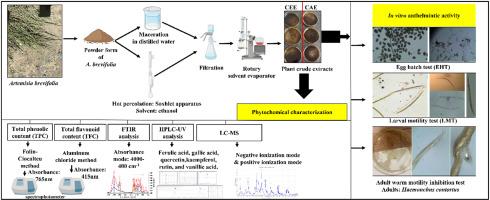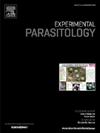Phytochemical characterization and insight into the in vitro anthelmintic activity of Artemisia brevifolia Wall ex Dc. against the different life stages of the gastrointestinal nematode of sheep
IF 1.6
4区 医学
Q3 PARASITOLOGY
引用次数: 0
Abstract
Gastrointestinal nematodes (GINs) are the major constraint to the production of small ruminants worldwide, causing significant losses in growth, productivity, and overall health. Clinical infections may linked to anaemia, diarrhoea, anorexia, oedema, and even mortality, whereas subclinical infections result in hidden production losses. Synthetic drugs are the primary means of control; however, their indiscriminate use has led to the emergence of parasite strains resistant to multiple classes of anthelmintics, this has created strong need for sustainable alternatives. Ethnomedicinal plants have emerged as promising alternative, with Artemisia brevifolia Wall ex Dc. is used as an anthelmintic remedy in small ruminants. The current study aimed to appraise the phytochemical characterization and in vitro anthelmintic activity of crude ethanolic extract (CEE) and crude aqueous extract (CAE) of A. brevifolia. CEE exhibited higher phenolic and flavonoid contents than CAE, with FTIR showing more distinct absorption peaks. HPLC-UV confirmed the presence of key phenolics (gallic acid, quercetin, ferulic acid, vanillic acid, and kaempferol), while LC-MS identified 33 compounds. Anthelmintic activity, assessed through egg hatch test (EHT), larval motility test (LMT), and adult worm motility inhibition assay (AWMIA), revealed that CEE exhibited 87.5 % egg hatch inhibition at 50 mg/mL and complete (100 %) adult worm motility inhibition after 8h post exposure (PE) at 25 mg/mL, while CAE showed 82.7 % and 63.3 % inhibition, respectively. Both extract exhibit dose dependent larvicidal activity. The findings of the present study divulged the remarkable phytochemical characterization and anthelmintic properties of A. brevifolia, and it could be a promising anthelmintic agent in veterinary medicine.

短叶蒿(Artemisia brevifolia Wall ex Dc)的植物化学特性及体外驱虫活性研究。针对绵羊胃肠道线虫的不同生命阶段。
胃肠道线虫(GINs)是全球小型反刍动物生产的主要制约因素,对生长、生产力和整体健康造成重大损失。临床感染可能与贫血、腹泻、厌食、水肿甚至死亡有关,而亚临床感染则导致隐性生产损失。合成药物是主要的管制手段;然而,它们的滥用导致寄生虫菌株对多种类型的驱虫药产生抗药性,这就产生了对可持续替代品的强烈需求。民族药用植物已成为有希望的替代选择,如短叶蒿。被用作小反刍动物的驱虫药。本研究旨在评价短叶蒿粗醇提物(CEE)和粗水提物(CAE)的植物化学特性和体外驱虫活性。CEE的酚类和类黄酮含量高于CAE, FTIR的吸收峰更明显。HPLC-UV确认了主要酚类物质(没食子酸、槲皮素、阿魏酸、香草酸和山奈酚)的存在,LC-MS鉴定了33个化合物。通过虫卵孵化试验(EHT)、幼虫运动试验(LMT)和成虫运动抑制试验(AWMIA)对虫卵活性进行评估,结果表明,在50 mg/ml浓度下,CEE对虫卵孵化的抑制率为87.5%,在25 mg/ml浓度下,暴露后8h (PE)对成虫运动的抑制率为100%,而CAE的抑制率分别为82.7%和63.3%。两种提取物均表现出剂量依赖性的杀幼虫活性。本研究结果揭示了短叶甲具有显著的植物化学特性和驱虫药特性,是一种很有发展前景的兽药驱虫剂。
本文章由计算机程序翻译,如有差异,请以英文原文为准。
求助全文
约1分钟内获得全文
求助全文
来源期刊

Experimental parasitology
医学-寄生虫学
CiteScore
3.10
自引率
4.80%
发文量
160
审稿时长
3 months
期刊介绍:
Experimental Parasitology emphasizes modern approaches to parasitology, including molecular biology and immunology. The journal features original research papers on the physiological, metabolic, immunologic, biochemical, nutritional, and chemotherapeutic aspects of parasites and host-parasite relationships.
 求助内容:
求助内容: 应助结果提醒方式:
应助结果提醒方式:


